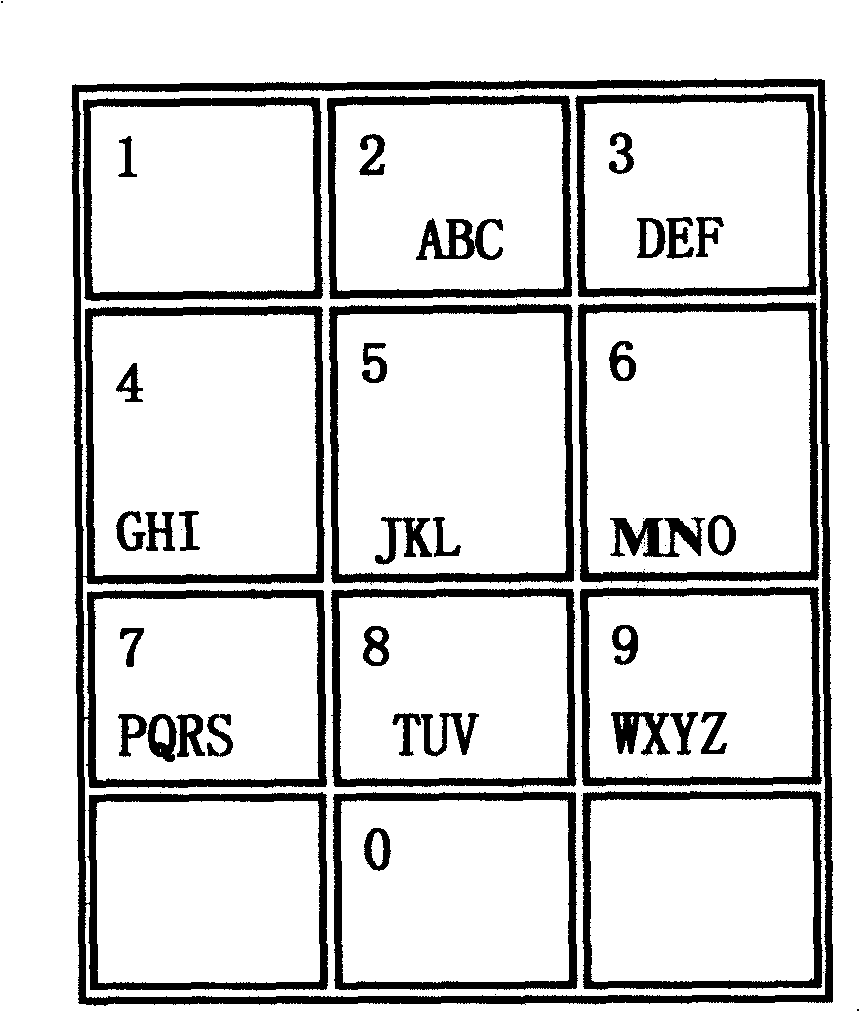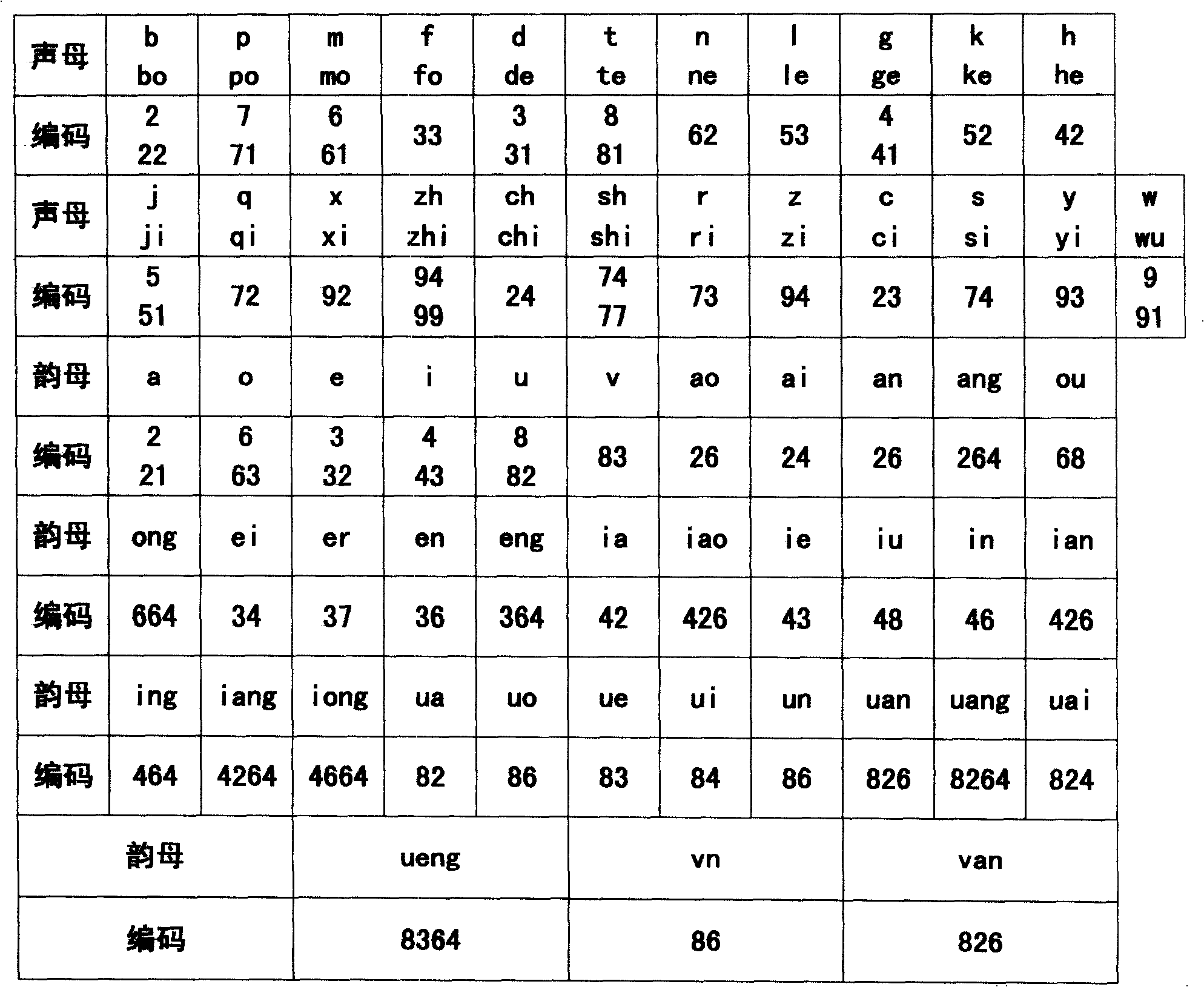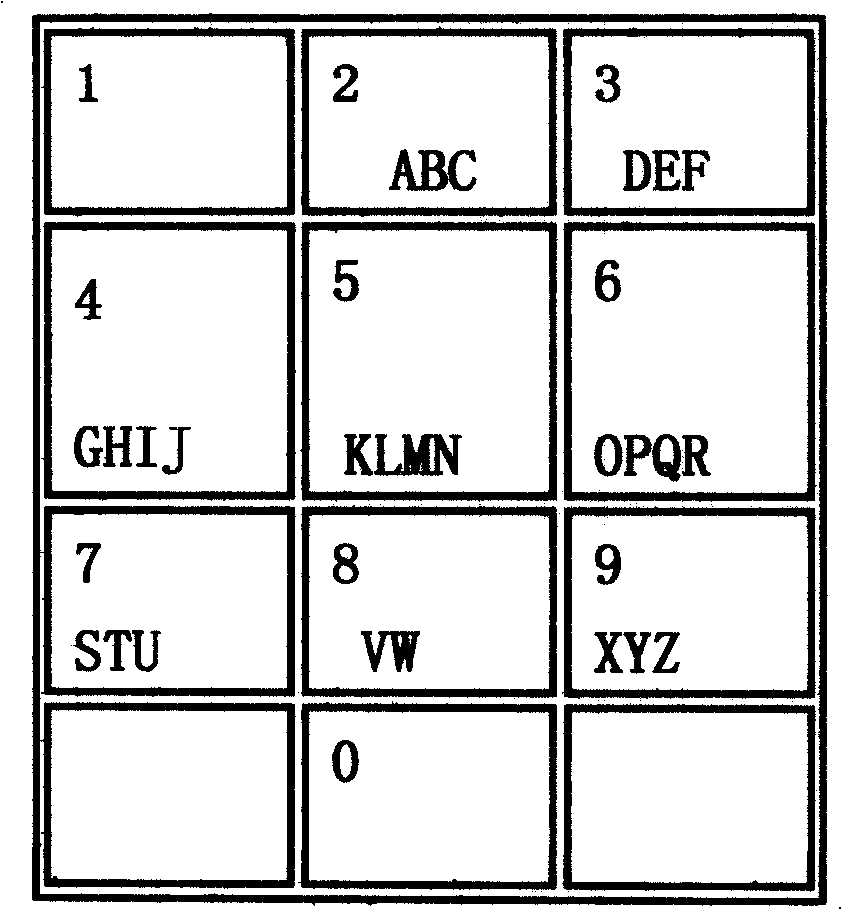Phonetic alphabet number locating Chinese character input method and keyboard
A digital positioning and pinyin alphabet technology, applied in the input/output process of data processing, electrical digital data processing, special data processing applications, etc., can solve the problems of less keystrokes, rote memorization, etc., and reduce the repetition rate , Improve the effect of input speed
- Summary
- Abstract
- Description
- Claims
- Application Information
AI Technical Summary
Problems solved by technology
Method used
Image
Examples
Embodiment 1
[0018] Embodiment one, such as Figure 1A , Figure 1B shown. Figure 1A According to the prior art, there are 1, 2, 3, 4, 5, 6, 7, 8, 9, 0 ten numeric keys and 26 English alphabets arranged in sequence on the disk surface, Figure 1B As shown in the comparison table, the numerical codes for determining the pinyin letters are:
[0019] (1) determine initial consonant b (bo), p (po), m (mo), f (fo), d (de), t (te), n (ne), l (le), g (ge), The digital codes of k(ke) and h(he) are 2(22), 7(71), 6(61), 33, 3(31), 8(81), 62, 53, 4(41), 52, 42; determine the initial consonants j(ji), q(qi), x(xi), zh(zhi), ch(chi), sh(shi), r(ri), z(zi), c(ci) , the digital codes of s(si), y(yi), and w(wu) are 5(51), 72, 92, 94(99), 24, 74(77), 73, 94, 23, 74, 93 respectively , 9(91).
[0020] (2) Determine the final vowel a, o, e, i, u, v (ü), ao, ai, an, ang, ou, and the digital codes are respectively 2 (21), 6 (63), 3 (32), 4(43), 8(82), 83, 26, 24, 26, 264, 68; determine the number of final...
Embodiment 2
[0022] Embodiment two, such as Figure 2A , Figure 2B shown. Figure 2A The English letters on the number subkeys 1, 2, and 3 remain unchanged, the English letter J on the original 5 number subkey jumps to the 4 number subkey, and the English letters M and N on the original 6 number subkey jump to the 5 number subkey key, P, Q, R jump to the 6-digit sub-key in turn, T, V jump to the 7-digit sub-key, W jump to the 8-digit sub-key. Figure 2B The numerical coding of the determined pinyin letters shown in the comparison table is:
[0023] (1) determine initial consonant b (bo), p (po), m (mo), f (fo), d (de), t (te), n (ne), l (le), g (ge), The digital codes of k(ke) and h(he) are 2(22), 6(62), 53, 33, 3(31), 72, 54, 52, 4(41), 5(51), 42 ; Determine initial consonants j(ji), q(qi), x(xi), zh(zhi), ch(chi), sh(shi), r(ri), z(zi), c(ci), s( si), y(yi), and w(wu) have digital codes of 44, 63, 9 (91), 94, 24, 74, 64, 93, 23, 7 (71), 92, 8 (82) respectively.
[0024] (2) Determ...
Embodiment 3
[0026] Embodiment three, such as Figure 3A , Figure 3B as shown, Figure 3A In addition to the English letter jumping to the previous number key, the English letter I shifts from the 4 number key to the 9 number key, and is in the 0, 1, 2, 3, 4, 5, 6, 7, 8, 9 subkeys The seven sub-keys of the keyboard are respectively provided with seven vowels ai, an, ao, ang, ing(ng), eng, ong words; Figure 3B The numerical encoding of the identified pinyin letters shown is:
[0027] (1), determine initial consonant b (bo), p (po), m (mo), f (fo), d (de), t (te), n (ne), l (le), g (ge) The digital codes of , k(ke), h(he) are 2(22), 6(62), 52, 33, 3(31), 73, 53, 51, 4(41), 44, 42 respectively; determine Initials j(ji), q(qi), x(xi), zh(zhi), ch(chi), sh(shi), r(ri), z(zi), c(ci), s(si) , y(yi), w(wu) are respectively 43, 63, 83, 94, 24, 74, 7(71), 93, 23, 72, 9(92), 8(82).
[0028](2), fully determine the digital codes of finals a, o, e, i, u, v(ü), ao, ai, an, ang, ou, respectively ...
PUM
 Login to View More
Login to View More Abstract
Description
Claims
Application Information
 Login to View More
Login to View More - R&D
- Intellectual Property
- Life Sciences
- Materials
- Tech Scout
- Unparalleled Data Quality
- Higher Quality Content
- 60% Fewer Hallucinations
Browse by: Latest US Patents, China's latest patents, Technical Efficacy Thesaurus, Application Domain, Technology Topic, Popular Technical Reports.
© 2025 PatSnap. All rights reserved.Legal|Privacy policy|Modern Slavery Act Transparency Statement|Sitemap|About US| Contact US: help@patsnap.com



